The Brazos Performance Preview: AMD E-350 Benchmarked
by Anand Lal Shimpi on November 16, 2010 12:01 AM ESTMobile IGP Comparison
I narrowed down the platforms for our mobile IGP comparison. I simulated a Core i3 350M by taking an i3-530, underclocking it (I couldn't do anything about the 4MB vs. 3MB L3 cache) and capping its GPU frequency at 667MHz. This is the best case scenario for the i3-350M, and as you'll see below, it doesn't really matter. I also paired a 2.2GHz Pentium Dual-Core with a G45 motherboard, agian simulating the cheaper mobile Pentium platform. Finally I installed Windows 7 on the 1.6GHz Core 2 Duo based 11-inch MacBook Air with its GeForce 320M to give you an idea of the upper bound for mobile performance with what might as well be a low end discrete GPU.
Updated: I've added performance results from a simulated Core i3-330UM, the E-350's competition in ultra portables.
We'll start with Modern Warfare 2:
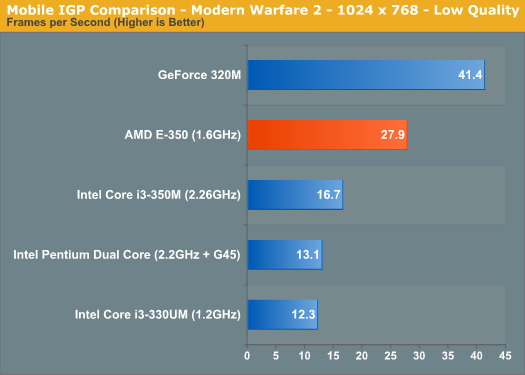
The E-350 puts the i3-350M, i3-330UM and Pentium DC to shame, delivering 67% better performance. The frame rate is just shy of being totally smooth however. I found that in most modern games 1024 x 768 would result in frame rates just under 30 fps.
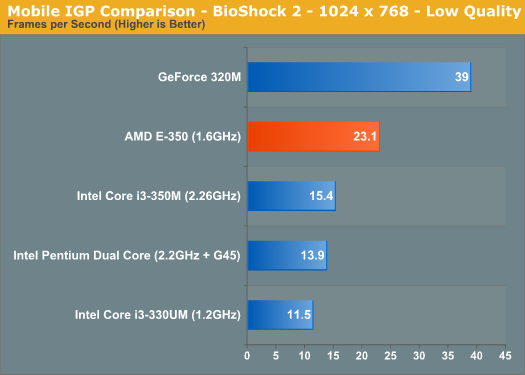
BioShock 2 showed a similar performance advantage. Again we're not able to break 30 fps but the performance advantage is huge compared to the Intel platforms with integrated graphics.
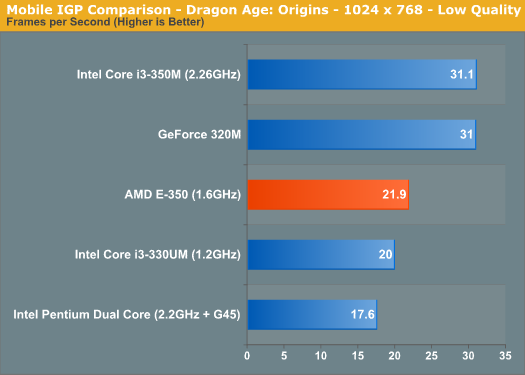
Dragon Age: Origins is mostly CPU bound at low quality settings and thus there's no real advantage to the E-350's Radeon HD 6310 GPU. It's faster than the Pentium/G45 platform, but significantly slower than the i3-350M. I expect most games however to be GPU bound at these settings across the board.
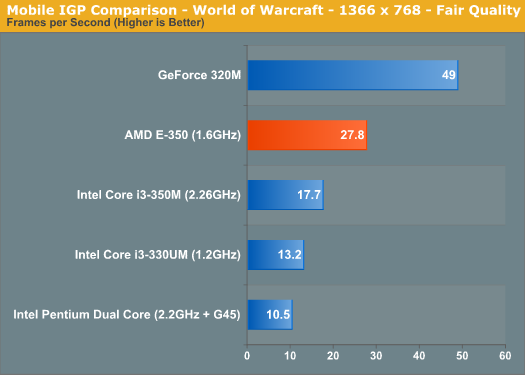
World of Warcraft continued the trend. The E-350 ended up 57% faster than the i3-350M, although still fell short of a discrete GPU.
Of course I wondered how well Brazos would play Starcraft 2:
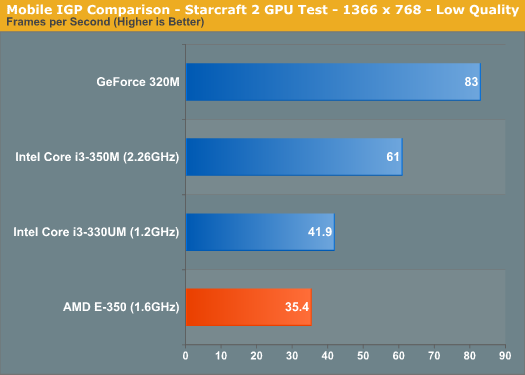
The GPU handles SC2 just fine, however the game is very CPU dependent and thus you see a pretty big advantage from the mainstream i3 system. The comparison is a lot closer when we look at the i3-330UM. The E-350 won't be able to play SC2 as well as a $500 mainstream notebook, but it'll be comparable to an ultraportable running ULV Arrandale.
We don't have numbers for the G45 platform here because the system wouldn't run our benchmark (our tests use an older version of SC2 which apparently had issues with the G45 drivers).
Our SC2 CPU test gives you an idea of the lower end of performance in large multiplayer battles:

The E-350 offers only 58% of the performance of the i3-350M system. The Bobcat cores do hold the platform back from time to time. Again, compared to the i3-330UM there's no performance difference at all.
Just for kicks I also ran the Civilization V benchmark, which gave us two datapoints: GPU performance and no-render/CPU performance.
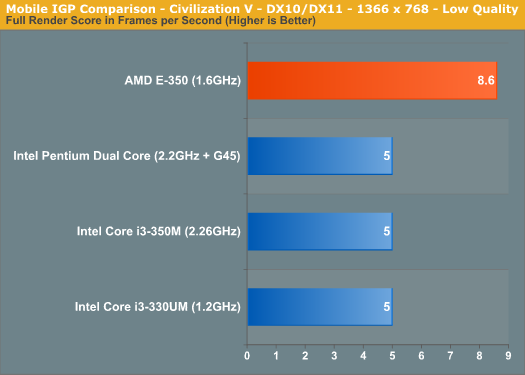
The benchmark doesn't score well on either platform, although AMD does hold a 72% performance advantage over the i3 and G45 platforms. The CPU test puts the E-350 at about 55% of the speed of the Pentium dual core platform.
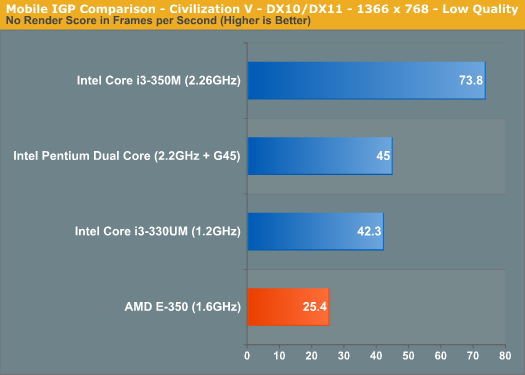
Civ V is one area where the Arrandale CPU advantage wins out over GPU performance.
Overall, the E-350 has no problems outperforming any of the current Intel integrated graphics offerings in 3D games. In CPU bound titles the E-350 loses out to the mainstream i3, but is competitive with ultra low voltage i3s. Just as with Atom, you'll have to sacrifice performance vs. a mainstream notebook, but compared to low voltage Arrandale the E-350 can hold its own.










207 Comments
View All Comments
silverblue - Wednesday, November 17, 2010 - link
Oh this is priceless. First we have all the anti-AMD accusations being spouted, and then YOU come in with the anti-Intel ones!rashire - Tuesday, November 16, 2010 - link
This article has me very interested for the potential as a HTPC. I've been looking for a compact (low draw) HTPC solution, I was looking at Atom + Ion combo, but I'm curious how this would preform comparatively. Mostly I'm interested in whether either system has enough power to playing x264 HD video (at a decently high bit rate) while also running par2 without any stutter in playback. (something my current socket 939 HTPC doesn't manage)Would definitely love more coverage on release for HTPC performance.
Brentnall - Tuesday, November 16, 2010 - link
Yes THIS!! +1Also recently been looking into a low power HTPC / File Server setup and the only reason I haven't gone for Atom + Ion yet is because AMD had some new stuff up their sleeves. Got to admit from reading other reviews, it looks pretty damn good compared to the atom, especially the power consumption... just hope the pricing is good too.
Couldn't care less about netbooks and laptops at the moment... more HTPC info please =D
Any ideas when we will start seeing some mobo's based on these chips?
nitrousoxide - Tuesday, November 16, 2010 - link
Current drivers can't give convincing performance boost on x264 HD Video decoding, but AMD will surely give better solutions by the time it ships its APUs. I remembered that when Anand tested the HD5450, it is clearly pointed out that 80 shaders don't have enough computing power to handle Vector Adaptive Deinterlacing, which is a important feature for a HTPC card. Given that HD6310 is slower than HD5450, it isn't a perfect HTPC solution either.nitrousoxide - Tuesday, November 16, 2010 - link
Anyway it could be competitive, though not PERFECT :)mino - Tuesday, November 16, 2010 - link
There will be Zacate boards with x16 PCIe slots for exactly those not willing to wait for Llano or not needing more CPU power.Dark_Archonis - Tuesday, November 16, 2010 - link
Zacate boards with x16 PCIe? What's the point? That's like offering SLI boards for Celeron processors.silverblue - Wednesday, November 17, 2010 - link
And there are i3s and i5s out there with on-die GPUs that have access to an x16 slot. By your logic, what's the point?If you come back and say you were referring to Celerons, please bear in mind there are probably people out there running SLi/Crossfire setups with an Athlon II at the heart. Bang for buck.
Shadowmaster625 - Tuesday, November 16, 2010 - link
Intel CULV processors are ungodly expensive. I dont see how the E-250 will be in the same price class. I did a price check on Core i3-330UM notebooks and they are ALL over $550. It is disingenuous to claim that those intel notebooks will be competing with the notebooks that will carry this tiny little chip.JarredWalton - Tuesday, November 16, 2010 - link
CULV is actually the brand for Core 2 ULV products, whereas ULV parts generally refer to the newer Core 2010 ULV stuff. ULV is certainly expensive, but not because it has to be... rather because Intel can charge that much and people will pay it. Even worse is that you can get nearly the same battery life with regular i3 processors (i.e. ASUS UL80Jt only gets about 30-45 minutes more battery life than the U30Jc). But if you look at CULV, which is where Brazos really competes, there's plenty of stuff selling around the $500 mark (search for Pentium Su4100 laptops).